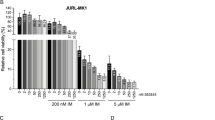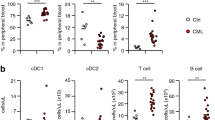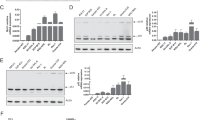Abstract
Bcr-Abl tyrosine kinase (TK) inhibitors are promising therapeutic agents for Bcr-Abl-positive (Bcr-Abl+) leukemias. Although they are known to promote caspase-mediated apoptosis, it remains unclear whether caspase-independent cell death-inducing mechanisms are also triggered. Here we demonstrated that INNO-406, a second-generation Bcr-Abl TK inhibitor, induces programmed cell death (PCD) in chronic myelogenous leukemia (CML) cell lines through both caspase-mediated and caspase-independent pathways. The latter pathways include caspase-independent apoptosis (CIA) and necrosis-like cell death (CIND), and the cell lines varied regarding which mechanism was elicited upon INNO-406 treatment. We also observed that the propensity toward CIA or CIND in cells was strongly associated with cellular dependency on apoptosome-mediated caspase activity. Cells that undergo CIND have a high apoptosome activity potential whereas cells that undergo CIA tend to have a lower potential. Moreover, we found that INNO-406 promotes autophagy. When autophagy was inhibited with chloroquine or gene knockdown of beclin1 by shRNA, INNO-406-induced cell death was enhanced, which indicates that the autophagic response of the tumor cells is protective. These findings suggest new insights into the biology and therapy of Bcr-Abl+ leukemias.
Similar content being viewed by others
Log in or create a free account to read this content
Gain free access to this article, as well as selected content from this journal and more on nature.com
or
Abbreviations
- AIF:
-
apoptosis-inducing factor
- ALL:
-
acute lymphoblastic leukemia
- Apaf-1:
-
apoptotic protease-activating factor-1
- BC:
-
blast crisis
- BM:
-
bone marrow
- CIA:
-
caspase-independent apoptosis
- CIND:
-
caspase-independent necrosis-like cell death
- CML:
-
chronic myelogenous leukemia
- CQ:
-
chloroquine
- cyt:
-
cytochrome
- DiOC6(3):
-
3,3′-dihexyloxacarbocyanine iodide
- EM:
-
electron microscopy
- HE:
-
hematoxilin–eosin
- IAP:
-
inhibitors of apoptosis protein
- IF:
-
immunofluorescent
- IgG:
-
immunoglobulin G
- IHC:
-
immunohistochemical
- LC3:
-
light chain 3
- LM:
-
light microscopy
- MOMP:
-
mitochondrial outer membrane permeabilization
- PB:
-
peripheral blood
- PCD:
-
programmed cell death
- Ph:
-
Philadelphia
- PI:
-
propidium iodide
- PI3K:
-
phosphoinositide-3-kinase
- STAT5:
-
signal transducer and activator of transcription
- TK:
-
tyrosine kinase
- WB:
-
western blotting
- XIAP:
-
X-linked inhibitor of apoptosis protein
- zVAD:
-
zVAD-fmk
- 3-MA:
-
3-methyladenine
- sh:
-
short hairpin
References
Druker BJ, Tamura S, Buchdunger E, Ohno S, Segal GM, Fanning S et al. Effects of a selective inhibitor of the Abl tyrosine kinase on the growth of Bcr-Abl positive cells. Nat Med 1996; 2: 561–566.
Melo JV, Deininger MW . Biology of chronic myelogenous leukemia – signaling pathways of initiation and transformation. Hematol Oncol Clin North Am 2004; 18: 545–568, vii–viii.
Druker BJ, Sawyers CL, Kantarjian H, Resta DJ, Reese SF, Ford JM et al. Activity of a specific inhibitor of the BCR-ABL tyrosine kinase in the blast crisis of chronic myeloid leukemia and acute lymphoblastic leukemia with the Philadelphia chromosome. N Engl J Med 2001; 344: 1038–1042.
Kimura S, Ashihara E, Maekawa T . New tyrosine kinase inhibitors in the treatment of chronic myeloid leukemia. Curr Pharm Biotechnol 2006; 7: 371–379.
Kuroda J, Puthalakath H, Cragg MS, Kelly PN, Bouillet P, Huang DC et al. Bim and Bad mediate imatinib-induced killing of Bcr/Abl+ leukemic cells, and resistance due to their loss is overcome by a BH3 mimetic. Proc Natl Acad Sci USA 2006; 103: 14907–14912.
O’Brien SG, Guilhot F, Larson RA, Gathmann I, Baccarani M, Cervantes F et al. Imatinib compared with interferon and low-dose cytarabine for newly diagnosed chronic-phase chronic myeloid leukemia. N Engl J Med 2003; 348: 994–1004.
Ottmann OG, Druker BJ, Sawyers CL, Goldman JM, Reiffers J, Silver RT et al. phase 2 study of imatinib in patients with relapsed or refractory Philadelphia chromosome-positive acute lymphoid leukemias. Blood 2002; 100: 1965–1971.
Druker BJ, Guilhot F, O’Brien SG, Gathmann I, Kantarjian H, Gattermann N, et al., IRIS Investigators. Five-year follow-up of patients receiving imatinib for chronic myeloid leukemia. N Engl J Med 2006; 355: 2408–2417.
Kimura S, Naito H, Segawa H, Kuroda J, Yuasa T, Sato K et al. NS-187, a potent and selective dual Bcr-Abl/Lyn tyrosine kinase inhibitor, is a novel agent for imatinib-resistant leukemia. Blood 2005; 106: 3948–3954.
Green DR, Kroemer G . The pathophysiology of mitochondrial cell death. Science 2004; 305: 626–629.
Kitanaka C, Kuchino Y . Caspase-independent programmed cell death with necrotic morphology. Cell Death Differ 1999; 6: 508–515.
Kroemer G, Martin SJ . Caspase-independent cell death. Nat Med 2005; 11: 725–730.
Leist M, Jaattela M . Four deaths and a funeral: from caspases to alternative mechanisms. Nat Rev Mol Cell Biol 2001; 2: 589–598.
Okada M, Adachi S, Imai T, Watanabe K, Toyokuni SY, Ueno M et al. A novel mechanism for imatinib mesylate-induced cell death of BCR-ABL-positive human leukemic cells: caspase-independent, necrosis-like programmed cell death mediated by serine protease activity. Blood 2004; 103: 2299–2307.
Dan S, Naito M, Tsuruo T . Selective induction of apoptosis in Philadelphia chromosome-positive chronic myelogenous leukemia cells by an inhibitor of BCR-ABL tyrosine kinase, CGP 57148. Cell Death Differ 1998; 5: 710–715.
Fang G, Kim CN, Perkins CL, Ramadevi N, Winton E, Wittmann S et al. CGP57148B (STI-571) induces differentiation and apoptosis and sensitizes Bcr-Abl-positive human leukemia cells to apoptosis due to antileukemic drugs. Blood 2000; 96: 2246–2253.
Okada H, Mak TW . Pathways of apoptotic and non-apoptotic death in tumour cells. Nat Rev Cancer 2004; 4: 592–603.
Vande Velde C, Cizeau J, Dubik D, Alimonti J, Brown T, Israels S et al. BNIP3 and genetic control of necrosis-like cell death through the mitochondrial permeability transition pore. Mol Cell Biol 2000; 20: 5454–5468.
Ertmer A, Huber V, Glich S, Yoshimori T, Erfle V, Duyster J et al. The anticancer drug imatinib induces cellular autophagy. Leukemia 2007; 21: 936–942.
Amaravadi RK, Yu D, Lum JJ, Bui T, Christophorou MA, Evan GI et al. Autophagy inhibition enhances therapy-induced apoptosis in a Myc-induced model of lymphoma. J Clin Invest 2007; 117: 326–336.
Boya P, Gonzalez-Polo RA, Casares N, Perfettini JL, Dessen P, Larochette N et al. Inhibition of macroautophagy triggers apoptosis. Mol Cell Biol 2005; 25: 1025–1040.
Degenhardt K, Mathew R, Beaudoin B, Bray K, Anderson D, Chen G et al. Autophagy promotes tumor cell survival and restricts necrosis, inflammation, and tumorigenesis. Cancer Cell 2006; 10: 51–64.
Tsujimoto Y, Shimizu S . Another way to die: autophagic programmed cell death. Cell Death Differ 2005; 12 (Suppl 2): 1528–1534.
Mashima T, Oh-hara T, Sato S, Mochizuki M, Sugimoto Y, Yamazaki K et al. p53-defective tumors with a functional apoptosome-mediated pathway: a new therapeutic target. J Natl Cancer Inst 2005; 97: 765–777.
Hait WN, Jin S, Yang JM . A matter of life or death (or both): understanding autophagy in cancer. Clin Cancer Res 2006; 12: 1961–1965.
Kabeya Y, Mizushima N, Ueno T, Yamamoto A, Kirisako T, Noda T et al. LC3, a mammalian homologue of yeast Apg8p, is localized in autophagosome membranes after processing. EMBO J 2000; 19: 5720–5728.
Lum JJ . Growth factor regulation of autophagy and cell survival in the absence of apoptosis. Cell 2005; 120: 237–248.
Samejima K, Tone S, Earnshaw WC . CAD/DFF40 nuclease is dispensable for high molecular weight DNA cleavage and stage I chromatin condensation in apoptosis. J Biol Chem 2001; 276: 45427–45432.
Deveraux QL, Roy N, Stennicke HR, Van Arsdale T, Zhou Q, Srinivasula SM et al. IAPs block apoptotic events induced by caspase-8 and cytochrome c by direct inhibition of distinct caspases. EMBO J 1998; 17: 2215–2223.
Chua BT, Guo K, Li P . Direct cleavage by the calcium-activated protease calpain can lead to inactivation of caspases. J Biol Chem 2000; 275: 5131–5135.
Barbouti A, Amorgianiotis C, Kolettas E, Kanavaros P, Galaris D . Hydrogen peroxide inhibits caspase-dependent apoptosis by inactivating procaspase-9 in an iron-dependent manner. Free Radical Bio Med 2007; 43: 1377–1387.
Kuroda J, Kimura S, Strasser A, Andreeff M, O’Reilly LA, Ashihara E et al. Apoptosis-based dual molecular targeting by INNO-406, a second-generation Bcr-Abl inhibitor, and ABT-737, an inhibitor of antiapoptotic Bcl-2 proteins, against Bcr-Abl-positive leukemia. Cell Death Differ 2007; 14: 1667–1677.
Strasser A, O’Connor L, Dixit VM . Apoptosis signaling. Annu Rev Biochem 2000; 69: 217–245.
Marsden VS, O’Connor L, O’Reilly LA, Silke J, Metcalf D, Ekert PG et al. Apoptosis initiated by Bcl-2-regulated caspase activation independently of the cytochrome c/Apaf-1/caspase-9 apoptosome. Nature 2002; 419: 634–637.
Liu JR, Opipari AW, Tan L, Jiang Y, Zhang Y, Tang H et al. Dysfunctional apoptosome activation in ovarian cancer: implications for chemoresistance. Cancer Res 2002; 62: 924–931.
Johnstone RW, Ruefli AA, Lowe SW . Apoptosis: a link between cancer genetics and chemotherapy. Cell 2002; 108: 153–164.
Bratton SB, Walker G, Srinivasula SM, Sun XM, Butterworth M, Alnemri ES et al. Recruitment, activation and retention of caspases-9 and -3 by Apaf-1 apoptosome and associated XIAP complexes. EMBO J 2001; 20: 998–1009.
Carter BZ, Kornblau SM, Tsao T, Wang RY, Schober WD, Milella M et al. Caspase-independent cell death in AML: caspase inhibition in vitro with pan-caspase inhibitors or in vivo by XIAP or Survivin does not affect cell survival or prognosis. Blood 2003; 102: 4179–4186.
McQueen T, Kornblau SM, Konopleva M, Edwards K, Andreeff M, Cortes J et al. Caspase-independent cell death in AML: an in vivo study in patients undergoing chemotherapy [abstract]. Blood 2001; 98: 208b.
Ito T, Tanaka H, Kimura A . Establishment and characterization of a novel imatinib-sensitive chronic myeloid leukemia cell line MYL, and an imatinib-resistant subline MYL-R showing overexpression of Lyn. Eur J Haematol 2007; 78: 417–431.
Acknowledgements
We are grateful to Professor T Yoshimori (Osaka University), Drs T Mashima (Cancer Chemotherapy Center, Japanese Foundation for Cancer Research), DC Huang (The Walter and Eliza Hall Institute of Medical Research), T Heike, YW Lin, Y Toda, M Fujioka, Y Nakagawa (Kyoto University), Y Kobayashi (Kyoto Second Red Cross Hospital), C Shimazaki (Kyoto Prefectural University of Medicine) and H Segawa (Shiga University of Medical Science) for their technical support, scientific advice, and gifts. This work was partly supported by Grants-in-Aids for Scientific Research from the Ministry of Education, Culture, Sports, Science and Technology of Japan (to TN and TM).
Author information
Authors and Affiliations
Corresponding author
Additional information
Edited by D Klionsky
Supplementary Information accompanies the paper on Cell Death and Differentiation website (http://www.nature.com/cdd)
Rights and permissions
About this article
Cite this article
Kamitsuji, Y., Kuroda, J., Kimura, S. et al. The Bcr-Abl kinase inhibitor INNO-406 induces autophagy and different modes of cell death execution in Bcr-Abl-positive leukemias. Cell Death Differ 15, 1712–1722 (2008). https://doi.org/10.1038/cdd.2008.107
Received:
Revised:
Accepted:
Published:
Issue date:
DOI: https://doi.org/10.1038/cdd.2008.107
Keywords
This article is cited by
-
Interaction of chloroquine with 2-(hydroxypropyl)-β-cyclodextrin through the supramolecular assembly for cytotoxicity on breast cancer cell lines
Monatshefte für Chemie - Chemical Monthly (2022)
-
Multikinase Abl/DDR/Src Inhibition Produces Optimal Effects for Tyrosine Kinase Inhibition in Neurodegeneration
Drugs in R&D (2019)
-
Dasatinib induces autophagy in mice with Bcr-Abl-positive leukemia
International Journal of Hematology (2017)
-
The Philadelphia chromosome in leukemogenesis
Chinese Journal of Cancer (2016)
-
Autophagy collaborates with ubiquitination to downregulate oncoprotein E2A/Pbx1 in B-cell acute lymphoblastic leukemia
Blood Cancer Journal (2015)



